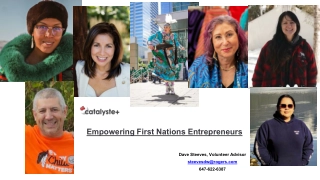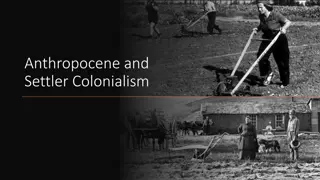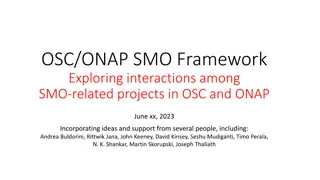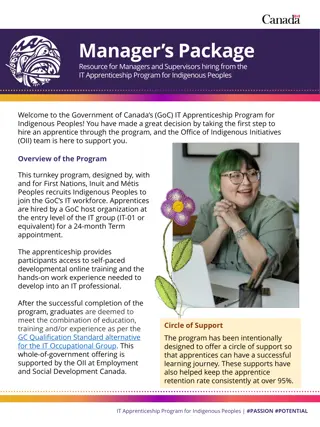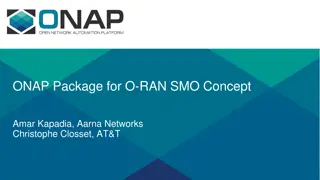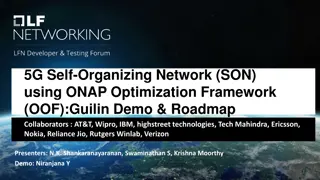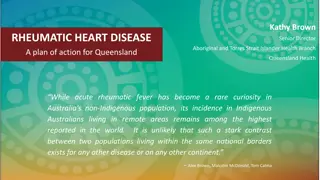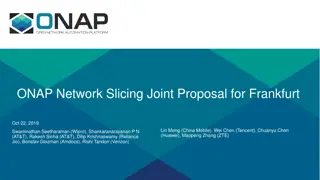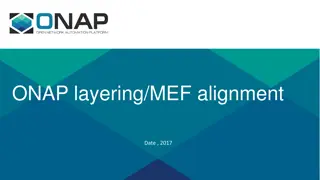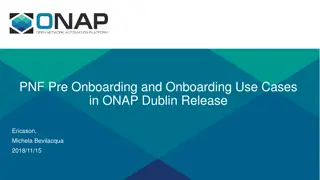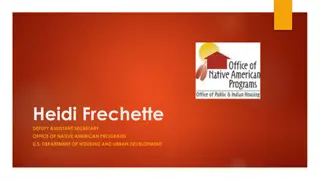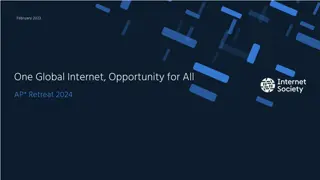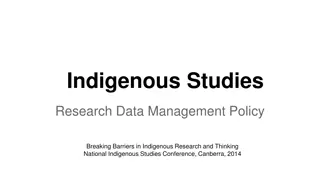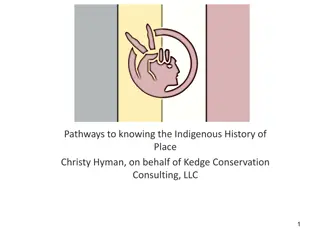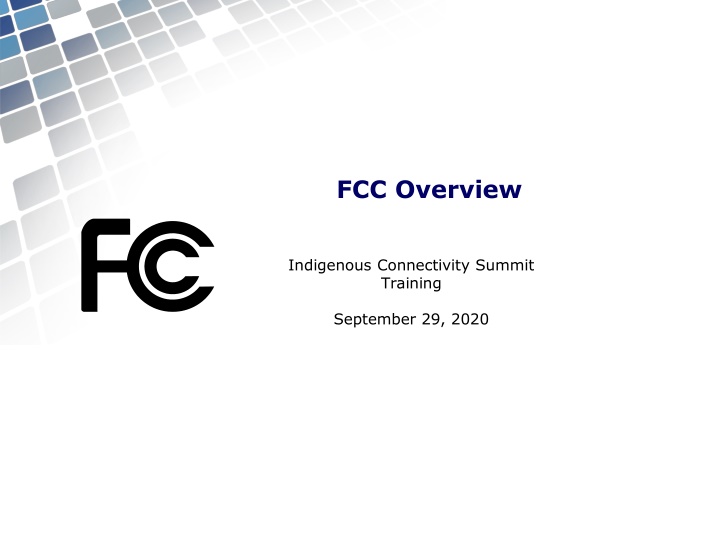
FCC's Mission, Governance, and Rulemaking Process
Discover insights into the Federal Communications Commission's mission, governance structure, regulatory authority, and rulemaking process. Explore the FCC's role in regulating communications, engaging with tribal communities, and addressing the digital divide. Learn about the organization's structure, regulatory initiatives, and commitment to promoting connectivity and universal service.
Download Presentation

Please find below an Image/Link to download the presentation.
The content on the website is provided AS IS for your information and personal use only. It may not be sold, licensed, or shared on other websites without obtaining consent from the author. If you encounter any issues during the download, it is possible that the publisher has removed the file from their server.
You are allowed to download the files provided on this website for personal or commercial use, subject to the condition that they are used lawfully. All files are the property of their respective owners.
The content on the website is provided AS IS for your information and personal use only. It may not be sold, licensed, or shared on other websites without obtaining consent from the author.
E N D
Presentation Transcript
FCC Overview Indigenous Connectivity Summit Training September 29, 2020
AGENDA Federal Communications Commission (FCC) Organization - Agency mission, governance, and structure - Regulatory authority and rulemaking process - Public input written filings and meetings Universal Service Fund Support Tribal Engagement and Initiatives - Office of Native Affairs and Policy (ONAP) - Native Nations Communications Task Force - Proceedings of interest - Tribal-specific broadband initiatives 2
THE FCCS MISSION The Federal Communications Commission is an independent government agency overseen by Congress Its mission includes: - Implementing and enforcing America s communications law and regulations - Regulating interstate and international communications by wire and radio in all 50 states, the District of Columbia, and U.S. territories - Covering wireline and wireless services, satellite, broadcast TV and radio, and cable TV 4
FCC GOVERNANCE AND STRUCTURE Five Commissioners - President nominates; Senate confirms - Appointed to fill five-year terms - No more than three from the same political party; President selects one Commissioner to be Chair Divided into Bureaus and Offices - 7 Bureaus: Wireless, Wireline, International, Enforcement, Consumer and Governmental Affairs, Media, Public Safety - 11 Offices: e.g., General Counsel, Legislative Affairs, Managing Director, Engineering and Technology 5
FCC REGULATORY AUTHORITY FCC establishes and enforces rules based on the substantive areas outlined in the Communications Act - The structure of the Act broadly mirrors the agency s Bureau organization, e.g., wireline, wireless, media and international - The Enforcement Bureau ensures the compliance of licensees, permitees, and other regulated entities The FCC also adopts rules and policies administered by certain outside entities - The FCC adopts the rules and policies governing the Universal Service Fund (USF), as authorized by Congress - The Universal Service Administrative Company (USAC) administers the USF programs and funding 6
FCC RULEMAKING PROCESS Rulemaking is a process for developing and issuing rules and regulations Once adopted, these rules and regulations establish the framework governing providers, including wireline and wireless services A top priority of FCC rulemaking activity is closing the digital divide and promoting broadband deployment nationwide 7
PUBLIC INPUT Notice and comment rulemaking process - The FCC depends on public comment to evaluate proposals and provide record support for rules - The record is public to promote transparency - FCC wants widespread input and different perspectives How to provide input - Written comments: share perspectives and help shape policies and rules; formal comments preserve appeal rights - In-person meetings: meetings with Commissioners and staff can supplement formal comments; substance must be summarized in writing in public ex parte filings - Comments and ex parte filings can be made and accessed online at: https://www.fcc.gov/ecfs/ 8
UNIVERSAL SERVICE FUND SUPPORT 9
USF BASICS Universal service the availability of affordable, reliable telecommunications service nationwide is a fundamental goal of federal telecom law USF established in 1997 to subsidize telecom services for low-income consumers, rural health care providers, schools and libraries, and consumers in high-cost areas Congressional authority in section 254(b) of the Communications Act 10
TRIBAL INITIATIVES AND ENGAGEMENT 11
OFFICE OF NATIVE AFFAIRS AND POLICY ONAP created by the Commission in 2010 Part of Consumer and Governmental Affairs Bureau s oversight of inter-governmental affairs Charged with bringing the benefits of modern communications infrastructure to all Native communities 12
ONAPS MISSION Ensuring robust government-to-government consultation with federally recognized Tribal governments Working within the Commission, as well as with other government agencies and private organizations, to develop and implement policies for assisting Native communities Ensuring Native concerns and voices are considered in all relevant Commission proceedings and initiatives Representing the Commission s positions on matters of interest to Tribal entities 13
NATIVE NATIONS COMMUNICATIONS TASK FORCE Latest version formed in November 2018 - 3-year term with meetings twice annually plus regular conference calls - 24 Tribal and 8 FCC members represent a diversity of views and expertise Tasked with providing guidance, expertise, and recommendations on issues affecting Tribal governments and people Input intended to inform and advance the Commission s efforts to close the digital divide affecting Indian country 14
NATIVE NATIONS COMMUNICATIONS TASK FORCE A report from the Tribal members of the Native Nations Communications Task Force entitled Improving and Increasing Broadband Deployment on Tribal Lands, was adopted in November 2019 and posted in December. The report addresses how to close the persistent digital divide between Indian country and the rest of America. It highlights Tribal success stories and provides potential solutions for policymakers that could benefit residents of Indian Country. 15
PROCEEDINGS OF TRIBAL INTEREST 16
2.5 GHZ Rural Tribal Priority Window First-of-its-kind opportunity for federally recognized Tribes to obtain licenses to unassigned mid-band spectrum over their rural Tribal lands Window scheduled to run from February 3, 2020 to August 3, 2020 was extended to September 2, 2020 to provide more time to Tribes impacted by the pandemic FCC staff fielded over 1,000 inquiries and provided one-on-one assistance to interested Tribal applicants throughout the pandemic Commission received more than 400 applications which are now being evaluated and processed; 157 have already been accepted for filing 17
Special Temporary Authority Special Temporary Authority (or STA) - Allows temporary use of spectrum in unique circumstances, such as natural disasters and pandemics - Spectrum provides additional capacity to meet increased demand for limited periods of time Tribal STAs - To date, six Tribal entities have received 2.5 GHz STAs (A:shiwi College & Career Readiness Center, Pueblo of Zuni; Navajo Nation; Makah Tribe; Lower Brule Sioux Tribe; Confederated Salish and Kootenai Tribes of the Flathead Nation; Santa Clara Pueblo) - STAs have been granted in other bands (700 MHz and 5.9 GHz) to providers serving Tribal lands (NTUA Wireless and Wind River Internet) 18
Rural Digital Opportunity Fund (RDOF) $20 billion investment in high-speed broadband networks in rural America in two phases over 10 years under Universal Service Fund (USF) high-cost program Funding through reverse auctions to service providers that deploy up to gigabit-speed networks - Phase 1 Auction 904 scheduled for October 2020 - Several Tribal entities have applied to participate Includes provisions that lower the cost threshold to make more Tribal lands eligible for bidding and increase the amount of support that can be made available for these areas 19
5G FUND NOTICE OF PROPOSED RULEMAKING In April, the Commission adopted a Notice of Proposed Rulemaking proposing to establish the 5G Fund for Rural America. 5G Fund would make up to $9 billion available to bring 5G mobile broadband services to rural areas that would otherwise be unlikely to see 5G deployments. As proposed, Phase I of the 5G Fund auction would reserve $680 million for providers that commit to serving eligible Tribal lands. 20
COVID-19 TELEHEALTH PROGRAM In March, the Commission created a new $200 million COVID- 19 Telehealth Program to support healthcare providers responding to the ongoing coronavirus pandemic within a week of Congress appropriating the funds as part of the CARES Act. By early July, the Commission had awarded the full $200 million to 539 recipients, including several providers serving Tribal communities. - The Navajo Nation Department of Health was awarded just over $950,000 in May to provide home-health care and remote monitoring services throughout the Navajo Nation to patients who are isolated and under shelter-in-place orders, including low- income, elderly, and vulnerable, high-risk patients. 21
Connected Care Pilot In April, the Commission created the Connected Care program, a three-year Pilot Program to provide up to $100 million of support from the Universal Service Fund to help defray health care providers costs of providing connected care services and to help assess how the USF can be used in the long-term to support telehealth. - The program is open to Tribal and other healthcare providers that provide services to Tribal communities. On September 3, the Commission issued guidance for all applicants. 22
LIFELINE PROGRAM WAIVERS In June 2020, the FCC streamlined the enrollment documentation required from Lifeline subscribers residing on Tribal lands to allow for immediate activation of services while the subscriber submitted the required materials. - This step helped Tribal lifeline subscribers immediately access needed connectivity during the pandemic. In August, in addition to several generally applicable waivers governing recertification, reverification, general de-enrollment, subscriber usage, and income documentation, the Commission extended the existing waivers to help subscribers residing in rural areas on Tribal lands to begin receiving Lifeline services more quickly. 23
QUESTIONS? sayuri.rajapakse@fcc.gov native@fcc.gov 24

